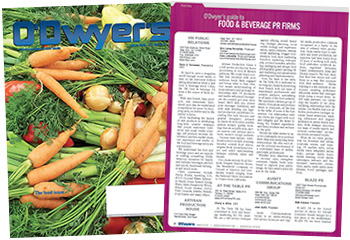 Andrea Pass |
There were more than 21,000 new food and beverage products introduced to the marketplace in 2016 alone, according to the United States Department of Agriculture. That can break down to 58 new launches each day. If you aren’t representing an already established and recognized brand, there can be a challenge when it comes to securing that much-needed media coverage to increase sales and ultimately, shelf-space.
The food and beverage space includes sub-categories such as snacks, bakery, dairy, meals and entrees, desserts, side dishes, breakfast cereals and more. Start by researching media coverage noting those specific product types to identify the press contacts who will find your food or beverage items most relevant to their area of coverage.
|
|
Contact trade publications. These magazines and newsletters are key to reaching buyers to secure additional retail opportunities for your brand. With trade media, editorial content focuses on the basics of the new product coupled with the value of retailers to carry the food item. Make sure to have both clear packaging and lifestyle imagery to accompany brand news.
Long-lead planning benefits year ‘round holiday meals
Recognizing buying habits contributes to successful press coverage. While milk, bread and eggs will always be staples on a shopping list, today’s consumer is looking for healthy choices, ready-to-eat options, portion-control packaging, modifications for dietary constraints — gluten-free, low sodium, vegan, vegetarian — as well as the tried-and-true snack and cereal categories.
Review media editorial calendars to tie-in press pitching with holiday food planning. For long-lead glossy magazine consideration, Thanksgiving review begins in the Spring while Christmas/Hanukkah preparation kicks off right after Memorial Day. February is Heart Health Month. Summer is all about grilling and, beginning in 2018, griddling. Begin long-lead media outreach in September. Tie your news in with specific holidays meals and target audiences to highlight the value of your new brand. Innovation in food is the trend for 2018. Recognize what makes your food product on-trend and work the angle.
Remember that every audience eats and drinks. Media outlets highlighting food are certainly important in your PR plan, but women’s, men’s, parenting, travel, health, sports and general lifestyle press, for example, also offer opportunities for reviews and incorporation of food and beverage in coverage.
Work with a chef or cookbook author to secure editorial coverage
There are a variety of ways to secure media coverage in the food and beverage space. Unfortunately, 2018 is turning into the year of pay-for-play in the world of what was once purely legitimate editorial coverage. To overcome the challenge and land television interviews, work directly with an established chef or cookbook author. This gives the opportunity to highlight the book while effectively working in the brand.
Satellite Media Tours offer an opportunity to conduct multiple television interviews around the country via one set studio on one set date. Oftentimes with a smaller budget for lesser known brands, the SMT provides a more cost-effective solution than traveling from city to city for broadcast segments. Keep in mind that most SMTs air on smaller market television outlets outside of the city limits from those in the top-tier designated market areas.
Bloggers and influencers effectively reach target audiences
New food and beverage brands can reach target audiences through relationships with key bloggers and influencers in specific categories. Influencers have a direct effect on the purchase decision by influencing the behavior or opinion of others. Those following bloggers and influencers are dedicated audiences. Vegans follow other vegans. Parents follow other parents. Beer lovers follow other beer lovers. The list goes on and on. Every day, new blogs appear. Every day, influencers grow their audience base.
While many influencers charge to write a review or post on social media, others are willing to provide honest reviews for receipt of product. An effective campaign will have a balance of both.
Tie in cause-related marketing
Budweiser secured tremendous media coverage by canning water and shipping to areas felt by devastating hurricanes and wildfires including Texas, Florida, Puerto Rico and California. The company’s Super Bowl ad drew high praise and strengthened the public’s positive impression of Anheuser-Busch.
For brands that are newer to the marketplace, local charitable contributions also garner positive media exposure. A soy milk company in New Jersey donated soy products including soy pudding to local food pantries. Local print and broadcast outlets covered the donation and the food banks were thrilled to have added recognition of their charitable work.
Provide clear, effective insights
The basic who, what, where, when, why and how still pertains to food and beverage public relations. While one might assume that the press understands a smoothie, for example, your brand’s smoothie must have unique characteristics, flavors, ingredients, price points and availability.
Demonstrate impact
How do you demonstrate to your client that you successfully broke through the clutter? Measure it! What was the share of voice for the brand at the beginning of the campaign, what was it mid-way through the campaign and what is the final outcome? Did the brand sentiment improve as a result, was market share taken from competitors in the appropriate product categories? Be sure to repurpose the media coverage via social media channels, email marketing, share with stakeholders, include in retail buyer presentations, and include on the news page of the website.
***
Andrea Pass is vice president of media relations for Marketing Maven, based out of its New York City office. She can be reached at [email protected].



 What the biggest meal of the day can teach us about serving up effective nutrition communications campaigns.
What the biggest meal of the day can teach us about serving up effective nutrition communications campaigns. Tips to refine and amplify your CPG brand strategy to win in 2024 and beyond.
Tips to refine and amplify your CPG brand strategy to win in 2024 and beyond. Strategic communications strategies for success in the growing “food is medicine” movement.
Strategic communications strategies for success in the growing “food is medicine” movement. How brands can authentically communicate sustainability issues and create a brand experience that’s compatible with consumers’ values.
How brands can authentically communicate sustainability issues and create a brand experience that’s compatible with consumers’ values. Communicating the effects that climate change and a growing world population have on our food system—and why change is needed.
Communicating the effects that climate change and a growing world population have on our food system—and why change is needed.


 Have a comment? Send it to
Have a comment? Send it to 
No comments have been submitted for this story yet.